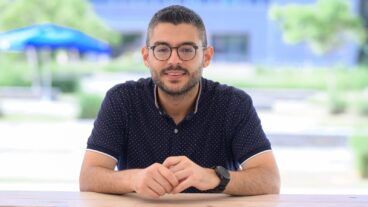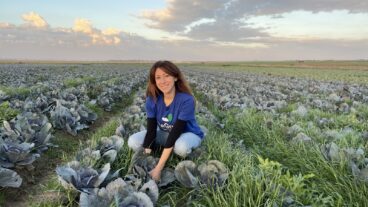Dr. Naftali Kaminski: There were many drugs for IPF, and I thought many of them were wrong.When Dr. Naftali Kaminski decided to research idiopathic pulmonary fibrosis (IPF), his mentors tried to talk him out of it. But that only increased his determination.
“It’s typical of an Israeli,” laughed the director of the University of Pittsburgh’s Richard Simmons Center. “We don’t know our place in the system. You’re a junior trainee, and you don’t listen to whatever anyone tells you, and do what you want.”
And it’s a good thing he didn’t listen to anyone, because today Kaminski is a world expert in IPF – a disease that inflames and scars air sacs deep within the lungs, making the lung tissues stiff and limiting their ability to transfer oxygen into the bloodstream. According to Kaminski’s research, more than 100,000 people worldwide are affected with IPF. Although smoking and exposure to dust increases a person’s risk, the disease’s exact causes are unclear.
“They come in with a little short breath, and markings on their chest X-ray, and you really know where they’re going. Thirty thousand patients die each year, 50% of them within three years,” Kaminski told ISRAEL21c. “The only treatment is lung transplanting, which is definitely not ideal.”
Kaminski trained in pulmonary medicine at Hadassah Medical School and at the Sheba Medical Center, and in 1996 left Israel to do a research fellowship at the University of California, San Francisco (UCSF). After returning to Sheba for many years, however, he was recruited back to Pittsburgh.
“The University of Pittsburgh got this big donation from [Pittsburgh area businessman]Richard Simmons to study IPF,” said Kaminski. “I was very excited because it’s a relatively unrecognized disease.”
The Simmons Center is probably the biggest center for interstitiallung diseases and IPF in the US – and the world.
“We have a very big clinical population of patients, and support groups and cognitive
behavioral therapy, since all these patients and their families need to plan and to deal with uncertainty. Our research component goes from very basic – mouse and molecule-by-molecule – to very clinical, trying new drugs and things like this,” Kaminski said.
During his Hadassah and Sheba years, Kaminski learned all too closely about the devastating effects of IPF.
“In Hadassah, I was basically in the same place all the time: I’d see patients first, second, third, fourth year and then they’d die,” he said, adding that it helped solidify his decision to buck his advisors and specialize in the disease. “There were many drugs for IPF, and I thought many of them were wrong.”
Kaminski not only helped eliminate the unproven therapies that poisoned many of the patients, he actually pioneered an entirely different way of studying IPF.
“I started relatively early applying genomic techniques to pulmonary fibrosis. ‘Genomic techniques’ mean that instead of looking at a single gene, you look at all the genes of the genome, which allows you to identify many more targets. It doesn’t only depend on intuition or fantasies – or scientific knowledge for that matter – but on your ability to analyze new chunks of data. You can look at 25,000 genes, do experiments, and come up with key regulatory molecules and pathways and so on,” he said.
This approach is at the fore of a broader trend that Kaminski adheres to called ‘systems biology’. The biological system isn’t studied in a reductionist way, a single molecule at a time, but as a whole.
“In a sense that’s what most people will say when you ask what’s wrong with their physicians: ‘They never look at me as a whole.'” You come in with a headache and the doctor never looks below the shoulders,” said Kaminski.
In his role at the Simmons Center, Kaminski places a big emphasis on collaborations and working in interdisciplinary teams.
“We have collaborators in Germany, Mexico, South Korea, Denver, San Francisco, everywhere. Groups are coming from different places, challenging dogmas: it’s an exciting era,” he said.
“If you’re looking from an Israeli point of view – and I’m not sure if it’s a good characteristic – it’s more natural for us to be interdisciplinary, deal with things we know nothing about and speak in complete confidence,” he laughed, adding that many of the collaborations, especially on the computational side, are with Israeli colleagues.
Kaminski is hopeful that within five to 10 years, his research will produce a computational model of IPF that will be able to diagnose and predict a patient’s susceptibility for the disease.
“I would plug in an age, and dust exposure, and genetic background, and I can predict if the person will develop pulmonary fibrosis and what treatment to give,” he said.
Kaminski would like to go even further in the diagnosis of IPF, using genome research.
“It’s the old question of why some get it bad and some easy. Everyone has this uncle who smoked, and lived to 90. With IPF, 50% die within three years, but we have patients that were diagnosed 12 years ago and are still okay. So is this something intrinsic to the patient, or is it the environment?”
“If in your genetic background there’s a severe diseases genotype, no matter what disease you get, you’ll get it faster. We’re trying to screen the whole genome and look at very minor variations. What people tend to think about genetics is that a big mutation causes a disease – but complex diseases are caused by a combination of very minor variations in our genome, over years.”
Kaminski has already made some progress in that area, receiving a half a million dollar grant to create a State of Pennsylvania registry.
“Many patients who never had access to care or diagnoses now will, and we hope that this will spread to other states,” he said.
He’s also optimistic about new drugs and compounds in the pipeline that are showing promise, based on studies conducted at the Simmons Center. say In addition to 400
patients at the center who have been offered to participate in various research projects, Kaminski’s team is now recruiting many more patients from all over the world.
The buzz over the studies resulted in additional funding from the National Institute of Health, and has raised interest in academic circles.
“We were the new kid on the block and did extremely well. As a result, many universities said ‘maybe idiopathic pulmonary fibrosis is something worth investing in,'” said Kaminski with some satisfaction.
“A year before I finished my fellowship I gave a presentation at UCSF; a famous editor of the biggest textbooks in pulmonary medicine said, ‘Why waste your career on these fibrotic sacks of tissues?'”












